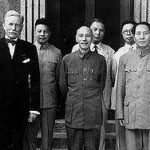History of the PRC – Part Nineteen Posted by sasha on May 20, 2011 in Culture
After many years of a brutle civil war between the CCP and the KMT, compounded with the invasion of the Japanese, things were not looking very good for China in the early 1940’s. However, everything changed on August 6, 1945, when the US dropped an atomic bomb on Hiroshima, Japan. Another bomb was used on the city of Nagasaki days later, and the Soviets also attacked the Japanese in Manchuria. Shortly thereafter, the Japanese finally surrendered to the Allies. Under the terms of their unconditional surrender, the Japanese were also ordered to surrender to KMT forces in China, but not to Mao and the CCP.
A short video with photos depicting Japan’s surrender to China in 1945 (Chinese/English).
A few weeks later, both Mao and Chiang would attend the first post-war peace conference in the city of Chongqing. While both sides argued for rebuilding the country and reaching a peace agreement, battles between them two continued all throughout the conference. As there were no KMT forces for Japan to surrender to in Manchuria, they instead gave in to the Soviets. Worried that the CCP would easily take over after the departure of the Soviets, Chiang struck a deal with the Russians to delay their withdrawal until he had moved enough men and material north. With assistance from the US, KMT troops were airlifted to many cities in the northern part of the country. Although the Soviets told Chiang they were on his side, they were going behind his back to aid Mao and the Communists, as Stalin wanted Mao to have control of northern Manchuria before he ordered his men out. The CCP was steadily growing in size and power. Perhaps their greatest assest was their ability to attract the landless, starving peasants in the countryside by promising them that they’d be able to take over farmland from their landlords if they fought for the CCP. This ensured Mao a limitless supply of manpower to fight against the KMT.
Of course, President Truman and the US were worried about the Soviets aiding the Chinese Communists:
It was perfectly clear to us that if we told the Japanese to lay down their arms immediately and march to the seaboard, the entire country would be taken over by the Communists. We therefore had to take the unusual step of using the enemy as a garrison until we could airlift Chinese National troops to South China and send Marines to guard the seaports”. – President Truman
Over 50,000 Marines were sent to guard strategic sites, over 500,000 KMT troops were equipped and trained, and hundreds of millions of dollars worth of military supplies and equipment were given to the KMT forces by the US. With peace talks breaking down, and the US and the Soviety Union both stepping into the equation, an all-out war soon resumed between China’s dueling forces.
On July 20, 1946, Chiang launched a large-scale assault to the Communist area with over 1.6 million troops. In mainland China, this final phase of the Civil War is known as the War of Liberation (解放战争 – Jiě fàng zhàn zhēng). With this war, we enter into the final chapter of the History of the People’s Republic of China. Stay tuned for the thrilling conclusion!

Build vocabulary, practice pronunciation, and more with Transparent Language Online. Available anytime, anywhere, on any device.
About the Author: sasha
Sasha is an English teacher, writer, photographer, and videographer from the great state of Michigan. Upon graduating from Michigan State University, he moved to China and spent 5+ years living, working, studying, and traveling there. He also studied Indonesian Language & Culture in Bali for a year. He and his wife run the travel blog Grateful Gypsies, and they're currently trying the digital nomad lifestyle across Latin America.






Leave a comment: